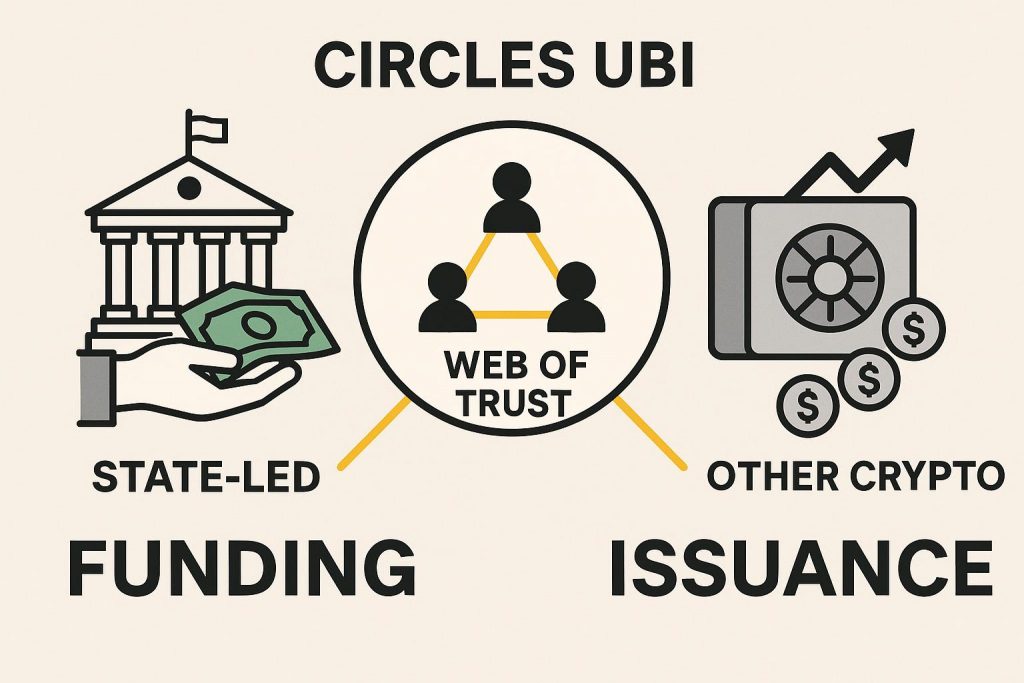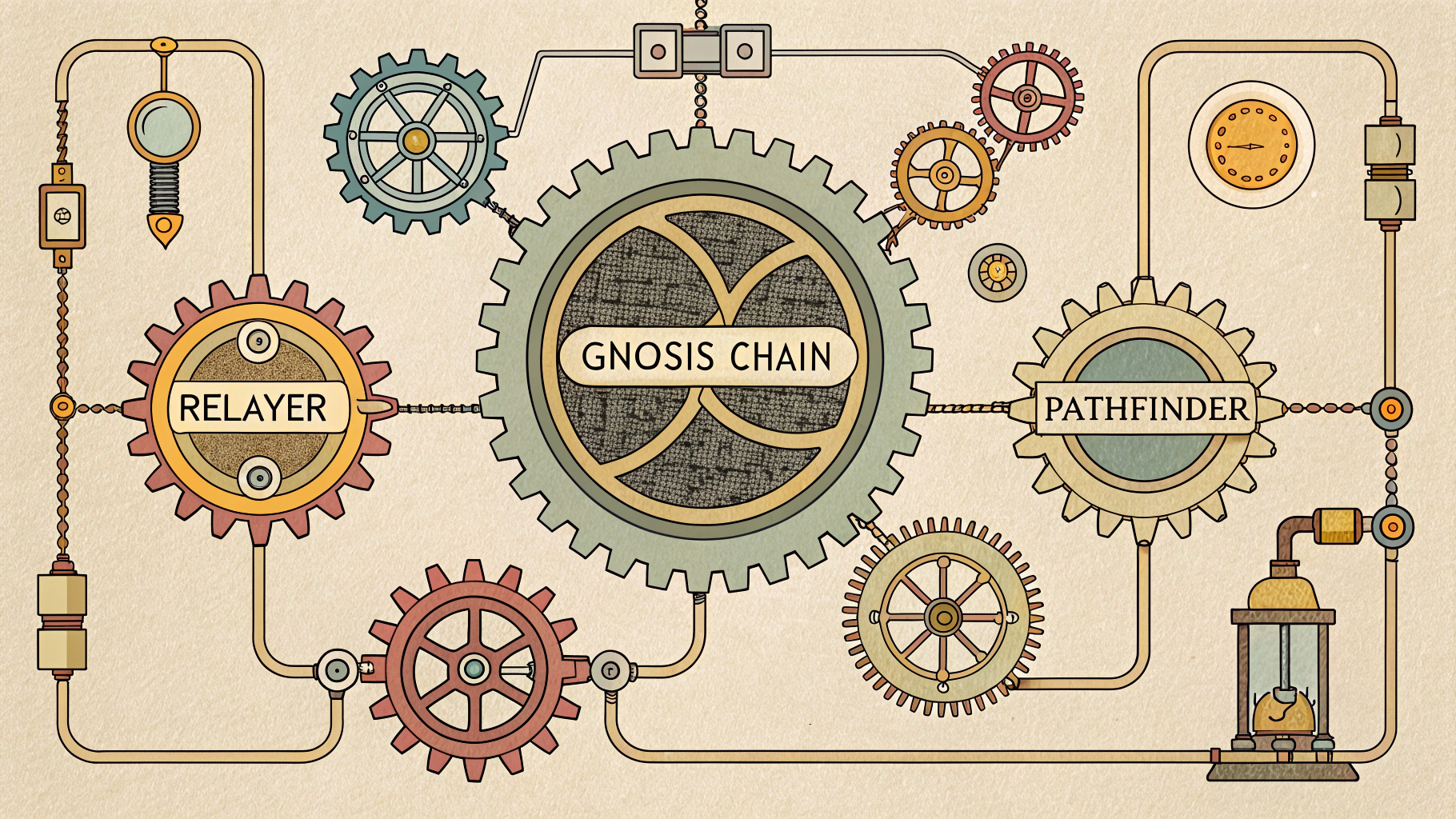Circles UBI Analysis: A High-Risk, High-Reward Bet on a Decentralized Economy

Preliminary Note on Naming Conventions: It is critical to distinguish Circles UBI, the subject of this report as detailed in its foundational whitepaper, from the financial technology company Circle, which issues the USDC stablecoin. Further, it should not be confused with a separate EU-funded research project also named CIRCLES, which focuses on food systems and microbiomes. This report will focus exclusively on the Circles UBI protocol. Irrelevant materials, such as those pertaining to the Wells Fargo “Milestone Circles” program, have been disregarded.
Part I: The Philosophical and Economic Foundations of Circles UBI
To comprehend the intricate mechanics and real-world applications of the Circles UBI project, one must first grasp its foundational premise. Circles is not merely a technological framework for distributing funds; it is an ambitious experiment aimed at fundamentally altering the nature of money itself. It emerges from a deep-seated critique of centralized, state-controlled monetary systems and proposes a radical alternative rooted in decentralized trust. This philosophical underpinning is the essential lens through which its technical architecture and pilot program outcomes must be viewed. The project’s design choices are less about optimizing a payment network and more about enacting a specific vision of a bottom-up, democratized economy.
Section 1: Reimagining Money – A 100% Bypass of State-Led UBI
The concept of a Universal Basic Income (UBI)—a regular, unconditional payment to all citizens—has a rich intellectual history, attracting proponents like Thomas Paine and Milton Friedman. In recent years, as wealth inequality has grown, public support for UBI has reached unprecedented levels. However, as detailed in the project’s official handbook, practical implementation remains elusive, often perceived as “too big to implement” and bogged down by the same political gridlock as global climate change action.
It is within this context of institutional paralysis that Circles UBI was conceived. The project’s whitepaper explicitly frames the emergence of global blockchain networks like Ethereum as a paradigm shift, offering a path to create universally accessible financial applications that can bypass traditional gatekeepers. This positions Circles not as a partner to the state, but as an alternative—a direct attempt to build a grassroots UBI that does not depend on a government for its existence or administration, a vision explored by its founders in various interviews.
This departure from state-centric models is the project’s defining characteristic. Core documents describe UBI not as a welfare program, but as a “transformative instrument” capable of “liberating currency from the confines of state control.” This language reveals that Circles is, at its heart, a political project aimed at challenging power dynamics. The system is built on the idea that money is not an object of inherent value but a set of “promises we make to one another,” as one founder puts it. By giving every individual the power to mint their own currency, Circles aims to empower them to issue these promises directly, claiming resources without permission from a central authority.
This vision stems directly from key figures like Martin Köppelmann, CEO of Gnosis, and Julio Linares, an activist with the Basic Income Earth Network (BIEN). Their stated goal was to foster local economies through a parallel system grounded in interpersonal trust. The project was also a reaction to the flaws of earlier cryptocurrencies. Köppelmann, once a Bitcoin maximalist, grew disillusioned with its tendency to concentrate wealth. Circles was thus born from a desire to create a “more democratic alternative to Bitcoin,” a “human-centered Bitcoin” that distributes new money equitably. The initial development, catalyzed by a €1 million commitment from Köppelmann, took seven years from idea to launch, as recounted in project histories.
Section 2: The Cryptoeconomics of Personal Currency and Trust
The economic engine of Circles UBI inverts the logic of mainstream economics, which derives value from scarcity. Instead, Circles generates value from the density of its social network, a concept operationalized through its core “Web of Trust” (WoT).
The mechanics begin with personal currency creation. When a user joins, a unique personal cryptocurrency is created for them via a smart contract. Every user mints their personal currency (CRC) at the same fixed rate: one CRC per hour, or 24 CRC per day. This continuous, equal issuance constitutes the system’s UBI property and is designed to be perpetually inflationary, a core concept outlined in the project’s documentation.
To counteract hoarding, the protocol includes a planned annual inflation rate of 7%, often described as a demurrage fee—a holding tax that causes balances to gradually decrease. This design choice is critical: it creates a strong incentive to circulate currency, promoting economic activity, as detailed in early project announcements.
This system’s value is unlocked through the Web of Trust. Technically, it is the primary defense against Sybil attacks (fake accounts). Instead of centralized ID verification, Circles outsources this to its users, who have a natural incentive not to trust fake accounts, as doing so would devalue their own network. Socially, trusting another user is a declaration that you will treat their currency as equivalent to your own. This mutual recognition enables “transitive exchange”: if Alice trusts Bob, and Bob trusts Carol, the system can find a payment path from Carol to Alice. The system’s value, therefore, is derived not from token scarcity but from the density of this social graph.
This onboarding mechanism, however, creates a fundamental tension. To join, a new user typically needs to be trusted by three existing members. While the creators describe it as permissionless, this structure has drawn credible criticism that it operates like a pyramid scheme, as debated in online forums. While economic flows are horizontal (peer-to-peer) rather than vertical, the optics are problematic and create a “cold start” problem for newcomers, risking the formation of exclusive cliques rather than a truly universal system.
Part II: The Technological Architecture
Translating Circles’ philosophy into a functional system required a sophisticated, evolving tech stack. V1 was a pragmatic build on existing infrastructure, but its limitations necessitated a complex layer of off-chain services. The lessons learned directly informed Circles 2.0, a significant evolution designed to address usability and liquidity by integrating with the Gnosis ecosystem.
Section 3: The V1 Protocol – A Risky Bet on Gnosis Chain
The first iteration of Circles was built on the Gnosis Chain (formerly xDAI), a choice driven by the need for lower transaction fees compared to the Ethereum mainnet. The on-chain architecture, detailed for developers, consisted of a set of core smart contracts:
- The Hub Contract: The protocol’s central nervous system, serving as a key-value database that stored trust connections and enforced the WoT rules.
- The Token Contract: Each user was assigned their own unique ERC-20 contract, responsible for the continuous minting of their currency.
- The Gnosis Safe Contract: Each user account was a Gnosis Safe, providing a secure, smart contract-based wallet with advanced features.
However, the inherent limitations of blockchain—slow speed and high computation costs—necessitated a substantial layer of centralized off-chain services. This included a relayer to pay for user gas fees, The Graph for indexing blockchain data, and a Pathfinder service. The Pathfinder, which calculated payment paths through the WoT using a max-flow algorithm, was essential for functionality but also a source of complexity and a significant scalability bottleneck.

This V1 architecture revealed a classic “decentralization paradox”: to build a usable decentralized app, the project had to lean on a stack of centralized services. While the core logic was secured on-chain, the components responsible for user experience were run on servers controlled by the Circles team. This created single points of failure that became evident during the project’s launch, when a surge of interest led to server crashes and a poor user experience, a failure acknowledged in a project retrospective.
Section 4: The 2.0 Evolution – Targeting Liquidity and Usability
Circles 2.0, which launched on May 21, 2025, represents a comprehensive redesign born from the failures of V1. Its central aim is to tackle the two most critical barriers to adoption—poor usability and a lack of liquidity—by leveraging the full power of the Gnosis ecosystem, a strategy detailed by its core development team.
To address usability, V2 introduces the Metri Wallet, a Progressive Web App (PWA) that simplifies the user experience with familiar Web2 interactions, including email sign-up and Passkeys for biometric authentication. To solve the critical problems of liquidity and stable value, V2 introduces Group Currencies, allowing users to unite their personal currencies under a common, shared ERC-20 token. More importantly, V2 integrates with Automated Market Makers (AMMs) like Balancer, allowing groups to create liquidity pools that back their CRC tokens with stablecoins. This creates a market-based price discovery mechanism and provides a “minimum guaranteed value” for CRC.
This evolution is made possible by a deep integration with the Gnosis ecosystem. The Gnosis Pay infrastructure allows users to spend Circles value at any merchant that accepts Visa, creating a direct bridge to the traditional economy. Further into the future, lessons from V1 have spurred the Entropy Project, a Gnosis Chain R&D initiative aiming to develop technologies for private participation in social networks, laying the groundwork for a future Circles that provides Sybil resistance without a fully public social graph, as explored in various research papers.
The strategic shift from V1 to V2 is a pivot from ideological purity toward pragmatic utility. V2’s features represent a concession that for an alternative currency to gain traction, it must interface with the existing financial system, not just attempt to replace it.
| V1 Problem | V2 Solution & Key Integrations | Strategic Rationale |
|---|---|---|
| Poor User Experience (Complex wallets, gas fees) | Metri Wallet with Passkey/biometric login; Gnosis Pay integration for Visa payments. | Acknowledges that mass adoption requires abstracting away blockchain complexity. |
| Lack of Liquidity & Stable Value (CRC only for goods/services) | AMM Integration for stablecoin backing; Gnosis DAO seeding liquidity program (€1.7M). | A pragmatic pivot from a purely closed-loop vision to a hybrid model. |
| Poor Fungibility (Unique, non-interchangeable tokens) | Group Currencies to unite personal tokens under a shared, fungible group token. | Addresses the cognitive and practical overhead of the original system. |
| Sybil Resistance vs. Privacy (Public Web of Trust) | The Entropy Project aims for anonymous trust verification (future goal). | Recognizes the long-term unsustainability of a fully public social graph. |
Part III: Real-World Experiments – Lessons from the Field
The theoretical frameworks of Circles UBI have been tested in two major pilot programs in Berlin, Germany, and Bali, Indonesia. Their starkly different outcomes provide a practical lens through which to analyze the project’s core value proposition. The Berlin pilot stands as a cautionary tale, while the Bali pilot offers a promising model for a community-centric strategy.
Section 5: The Berlin Pilot – A Cautionary Tale of 90% Economic Leakage
The Circles UBI pilot in Berlin, active from late 2020 until the Circles Coop ceased operations in late 2023, was the project’s first major implementation. The newly formed Circles Coop aimed to create a vibrant, self-sustaining circular economy, and by March 2022, they had onboarded 20 businesses, including food producers and co-working spaces.
A central pillar was a subsidy program, funded by over €2.3 million in donations, allowing businesses to convert CRC into Euros (EUR). The hope was to incentivize CRC acceptance and create a marketplace for users.

Despite significant funding, the pilot was ultimately deemed a failure. The subsidy program became an exit ramp, with most participating businesses cashing out 90% of their CRC into EUR. They used CRC as a temporary revenue supplement, not a medium to be circulated. The pilot failed to create a closed-loop B2B supply chain, meaning the powerful “fiat gravity” of the mainstream economy continuously pulled value out of the system. This economic failure was compounded by the technological fragility of the V1 protocol, which suffered from scalability issues and a poor user experience.
The Berlin pilot’s collapse starkly demonstrated that an alternative currency cannot survive on subsidies alone. It must solve a real economic coordination problem. The lessons learned directly informed the more pragmatic design of Circles 2.0.
Section 6: The Bali Pilot – A Model for Community-First Integration
In stark contrast, the Circles UBI pilot in Bali represents a research-driven, community-first approach. In 2021, the team conducted in-depth surveys with 494 people to understand local needs before building. An overwhelming 97% of respondents expressed enthusiasm, and the app was developed based on this feedback.
A cornerstone of the Bali strategy was integrating with the ‘Banjar’ system—a traditional form of neighborhood governance. This provided Circles with a pre-existing, high-trust social infrastructure. The project also gained legitimacy through partnerships with local firms and, most significantly, Indonesia’s National Research and Innovation Agency (BRIN).

The results have been remarkable. As of late 2023, the Bali pilot was responsible for an astonishing 90% of all transactions in the entire global Circles ecosystem. By 2024, the pilot had grown to over 1,500 participants who had exchanged more than 1,000,000 CRC for real-world goods. With a local valuation of roughly 1 CRC to 1 banana, the daily UBI of 24 CRC provides a value equivalent to about 27% of the minimum wage in Bali, offering a meaningful impact.
The collaboration with BRIN culminated in a formal impact assessment report in 2024. The existence of such a study, conducted by a national agency, is a major milestone in providing empirical evidence of the program’s positive impact on community resilience and well-being, with key findings and data available for download. The Bali pilot proves that the key determinant of success is the strength of social infrastructure, not just the sophistication of the technology.
Part IV: Critical Analysis and Future Outlook
Synthesizing the project’s foundations, technology, and real-world outcomes allows for a comprehensive critical analysis. By placing Circles in a comparative context, we can better appreciate its unique nature, distinct challenges, and future prospects.
Section 7: A Comparative Perspective on UBI Models
Circles UBI is fundamentally different from both state-led programs and other crypto-based projects.
Compared to state-led UBI trials, like those studied by organizations such as GiveDirectly, the primary distinction is the source of money. State UBIs redistribute existing wealth via taxation. Circles, in contrast, enables the creation of new money through mutual agreement.
The comparison with other Crypto UBI projects is equally revealing. Projects like GoodDollar and ImpactMarket operate on a reserve-backed or donation-based model, where yield from staked assets funds the UBI. Worldcoin uses biometric iris scans for its “proof-of-humanity.” Circles stands apart. Its value is purely endogenous, created from within the network through the Web of Trust.
| Model | State-Led UBI | Reserve-Backed Crypto UBI (e.g., GoodDollar) | Circles UBI |
|---|---|---|---|
| Funding Source | Taxation / Government Revenue | Yield from staked crypto assets donated by supporters | Mutual agreement; self-issuance of currency |
| Issuance Mechanism | Centralized distribution of fiat currency | Smart contracts distribute yield-generated tokens | Smart contracts mint new personal currency for each user |
| Governance | Government / Bureaucratic | Foundation or DAO, dependent on funders | Decentralized, community-based |
| Sybil Resistance | National ID systems | Third-party verification or biometrics (e.g., Worldcoin) | Web of Trust (WoT); social verification |
| Value Proposition | Social safety net; poverty reduction | Financial inclusion; efficient cross-border aid | Creation of a new, parallel, community-owned economy |
| Key Challenge | Political will; cost to taxpayers | Attracting sufficient capital to generate meaningful yield | Bootstrapping the network effect; creating a closed-loop economy |
Section 8: Challenges, Criticisms, and The Path Forward
Despite its innovative design, Circles UBI faces significant challenges. The “pyramid scheme” accusation, stemming from its invite-only onboarding, persists. While economically inaccurate, the structural similarity to MLM recruitment is an undeniable optics problem that undermines its claim to universality.
A more technical critique concerns the “double-spend problem” in a web-of-trust context, which posits that the system may still require a form of global consensus to prevent a user from spending the same value across different trust paths, potentially negating some of its benefits over traditional blockchains.
Beyond these critiques, practical challenges remain. Scalability is a major question. The “fiat-gravity” problem, demonstrated in Berlin, is an immense hurdle. And user adoption and education are monumental tasks, as the core concepts are deeply counter-intuitive.
The path forward is Circles 2.0, with its focus on usability and liquidity, modeled on the patient, community-led strategy of the Bali pilot. In the long term, the Entropy Project represents the R&D frontier, aiming to solve the deep challenges of privacy and identity.
Ultimately, the success of Circles UBI will be determined by its ability to foster a new economic culture. The project asks participants to shift their understanding of money from a scarce object to an abundant tool for exchange. The Berlin pilot failed because the culture was not strong enough; the Bali pilot is succeeding because it is tapping into a pre-existing culture of cooperation. Circles is a high-risk, high-reward experiment to see if a community can consciously agree on a new set of rules for creating value. Its final impact will be measured not in the market price of its token, but in its ability to change human behavior and build resilient, localized, and more equitable economies.

